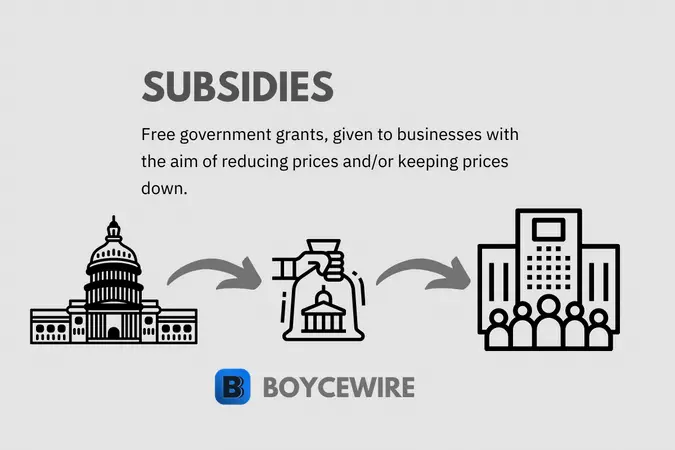Subsidies: Definition, Examples, Pros & Cons

Subsidies Definition
Subsidies are a means by which governments give money to private firms, usually to keep prices low, or, to protect the firm and jobs.This can be accomplished through a direct cash payment or by providing a tax cut or other form of indirect support.
There are two main types of subsidies – direct and indirect subsidies. For example, direct payments occur when government transfers cash straight to the firm. By contrast, indirect payments occur when there is not a specific monetary amount. Indirect subsidies can take many forms, including government-backed loans and payments in kind.
Key Points
- Subsidies are payments made by government in order to protect jobs and/or keep prices of final goods down.
- There are two types of subsidies – indirect and direct.
- Critics of subsidies note they are an inefficient use of resources and can create perverse incentives – as is the case of dairy production in the US.
Types of Subsidies
Direct Subsidies
A direct subsidy is where the government provides payment to a party by which no goods or services are exchanged. So a payment is made, but the government receives nothing in return.
Direct subsidies can include payments to both private businesses, as well as low-income households. So this could include housing benefits, or food vouchers to low-income households, or ‘cash in the bank’ payments to private firms.
Indirect Subsidies
Indirect subsidies are those that offer a third party a benefit without a specific monetary value. For example, we can consider government-backed loans as a type of subsidy. It is not a cash transfer but does provide specific firms with a benefit.
In short, direct subsidies are cash payments to third parties. At the same time, indirect subsidies provide a benefit that is not paid specifically to the third party.
Examples of Subsidies
Subsidies are a payment from government to private entities, usually to ensure firms stay in business and protect jobs. Examples include agriculture, electric cars, green energy, oil and gas, green energy, transport, and welfare payments.
1. Agriculture
Agriculture is one of the most subsidised industries in the world. Almost every developed nation offers one except for New Zealand. The sums are large, with the US subsidising the industry to the tune of $20 billion per year. However, this is nothing compared to the EU, which spends $65 billion per year.
We can link the reasoning for such protections back to the damaging World Wars that occurred in the past century. Food is obviously a necessary requirement and a country that is dependent on foreign powers could find itself vulnerable.

2. Electric Car
With the prevalence of climate change, governments are financially encouraging alternatives such as Electric Vehicles. In the US for example, it offers customers subsidy of up to $7,500. The aim is to reduce the dependency on petrol and diesel and shift towards a greener solution.
3. Fossil Fuel
Rather ironically, governments also subsidise fossil fuels at the same time as green energy. In an IMF report, it found the biggest subsidies were provided by: China ($1.4 trillion), United States ($649 billion), Russia ($551 billion), and the European Union ($289 billion). The reason being is that despite the shift towards green energy, there are millions of jobs that are still dependent on the use of fossil fuels.
4. Green Energy
With climate change becoming a more prominent issue, governments are looking to invest in new technology. As a result, most developed world governments provide some kind of subsidy to the industry. In the US for example, it subsidised the industry by $17 billion in 2016.
5. Steel
Steel is another example of an industry which relies on government subsidies – largely in order to protect and preserve defence and security. For example, in times of war, this industry is a crucial party of a nations defence. At the same time, it is also a crucial component for many industries such as manufacturing. Often subsidies are used to protect domestic suppliers against foreign competition – particularly cheap Chinese exports.
6. Transport
Most developed countries offer subsidies to railway and bus firms. In the US for example, it pays rail firm Amtrak over $2 billion in subsidies. There have also been occasional subsides for the purchase of new motor vehicles. For example, in 2009, the US government introduced a scrappage scheme, which allowed consumers to trade in old cars for a government supported cash discount on new cars.

7. Welfare Payments
A slightly different type of subsidy as it goes direct to consumers. However, welfare payments are the biggest subsidy, with the US spending $1.1 trillion a year. Whilst welfare payments may not seem like a subsidy, it classifies as one as money is being transferred without an exchange taking place.
Advantages of Subsidies
When looking at the benefits subsidies provide, we must also consider its effects – this is because they often have trade-offs. For each benefit, a subsidy provides, there is an equal and opposite negative effect. The question, therefore, must be whether such benefits are worth such costs.
1. Help the Poor
Subsidies such as house or unemployment benefit can assist the poor out of poverty. By providing a lifeline to those without a job, they may be able to find their feet and get back into employment – potentially providing income to government in the long-term.
2. Positive Externalities
Government-back student loans for example may create a better-educated workforce. Businesses can, therefore, benefit from higher-skilled workers. Such subsidies may cost the government in the short term, but could pay themselves back in the long-term through higher economic growth and tax revenues.
3. Increase Supply or Demand
In the US, the government subsidises the production of milk – which has encouraged farmers to increase production. That increase in production has created an excess in supply and forced suppliers to reduce prices – which in turn can increase demand.
4. Prevent Industry Decline
Some industries face tough market conditions – especially from international competition. For example, governments generally consider steel production a necessity for defence – therefore, they seek to protect it from cheaper international competition. Other industries are just naturally uncompetitive, but governments subsidise them in order to maintain jobs in that industry.
5. Reduce Negative Externalities
By subsidising one industry, the government can direct demand for such. For example, governments often public transport subsidies such as buses and trains. As it is cheaper for the consumer, they are more likely to use such than a car or motorbike. Therefore, it reduces the negative emission effects that occur from such motor vehicles.
6. Protect Jobs
Subsidising industry can help prevent its decline and subsequently the jobs associated. By financing industries through subsidies, it allows them to continue in business – thereby protecting those jobs. These subsidies are often required over the long-term as the industry may face cost and price pressures from international competition that are more efficient.
Disadvantages of Subsides
Whilst looking at the negatives of subsidies, it is important to remember the trade-offs. Even though higher taxes may be necessary, is the result and benefit worth the cost? Furthermore, who should decide if those costs are worth it?
1. Dependency
It is argued that social benefits such as housing and unemployment can create a state of dependency. If the recipient does not benefit from working, then they won’t seek out work. This can be seen as government failure. The recipient is dis-incentivised to get a job but needs that job to learn and develop skills to go onto better-paid jobs.
2. Create Inefficiencies
A subsidy reduces the incentives to cut costs and create efficiencies. Businesses that rely on government handouts know that they can be unprofitable, but still stay in business thanks to the taxpayer.
3. Excess Supply
Subsidies such as agriculture can create perverse incentives. They guarantee farmers a set income for goods such as dairy as they operate as a buyer of last resort. So they can produce as much dairy as they like and the government will buy and excess. Consequently, farmers are strongly encouraged to produce such products.
4. Higher Taxes
Perhaps one of the most overlooked negatives of subsidies is higher taxes. If the government is spending more money, it will come at the cost of the taxpayer. This may be in the short term, or the long term if it is paid for by debt.
5. Difficulty Removing
Once a subsidy is put in place, it becomes incredibly hard to remove. This is because those who benefit are actively encouraged to lobby government officials to maintain it.
6. Measuring Success
The success of subsides can vary. Some have significant side effects, and some have some positives. However, when deciding whether government intervention is necessary, it is almost impossible to determine whether there will be a net benefit or a net loss.
The Economics of Government Subsidies
In economics, governments provide subsidies to resolve market failures. This may be because: there is insufficient supply, it is unprofitable to private firms, or some consumers are left out of the market.
In markets such as College / University education – the government sees a lack of demand. The logic goes that if more people are reaching a College level education, then the overall population will benefit from higher productivity. College graduates are more knowledgeable and therefore provide greater benefit to firms. It is therefore seen as a market failure because private firms will not provide enough investment to cover students’ costs.
Student loans are highly risky, so students would either have to pay astronomical interest or not have access at all. This would provide a great disincentive for students to attend college. Consequently, governments provide a guarantee to encourage private investment and students to attend college.
So the aim of the government is to lead to optimal outcomes and align supply and demand. However, whilst government subsidies may assist in some way, they often have unintended consequences. Rent controls for example restrict prices but actually increase demand further.
What happens as a result is that property developers are dis-incentivized to build rental properties. At the same time, existing landlords would rather sell their property than rent it out at a loss, only furthering the decline in rental supply.
FAQs on Subsidies
A subsidy is money given to private firms by the government. Recipients do not have to pay this sum back, so it is essentially free money.
Governments will identify areas of the economy that need financial assistance, or areas which need greater investment – for instance, green energy or agriculture. It then provides financial assistance, either in order to encourage production of certain goods, or perhaps to help the company reduce prices for consumers. The overall aim depends on the type of subsidy, but may be to reduce prices to the consumer, keep people employed, or increase the production of certain goods.
There are two types of subsidies: direct and indirect subsidies.
A direct subsidy is where government provides payment to a this party by which no goods or services are exchanged. By contrast, indirect subsidies are those that offer a third party a benefit without a specific monetary value.
Examples of subsidies include:
1. Transport
2. Green Energy
3. Agriculture
4. Fossil Fuel
5. Welfare Payments
6. Electric Cars
The tax-payer is ultimately the one who pays for subsidies. Governments pay for subsidies through the funds they receive from general taxation, which they get from working individuals.
About Paul
Paul Boyce is an economics editor with over 10 years experience in the industry. Currently working as a consultant within the financial services sector, Paul is the CEO and chief editor of BoyceWire. He has written publications for FEE, the Mises Institute, and many others.

Related Topics
Further Reading
 Commercialization - Commercialization refers to the process of introducing a new product, service, or innovation into the market with the aim of…
Commercialization - Commercialization refers to the process of introducing a new product, service, or innovation into the market with the aim of…  Capital Asset Pricing Model - The Capital Asset Pricing Model (CAPM) is a financial model used to estimate the expected return on an investment based…
Capital Asset Pricing Model - The Capital Asset Pricing Model (CAPM) is a financial model used to estimate the expected return on an investment based…  Cluster Sampling - Cluster sampling is a sampling technique in which the population is divided into groups or clusters, and a subset of…
Cluster Sampling - Cluster sampling is a sampling technique in which the population is divided into groups or clusters, and a subset of… 